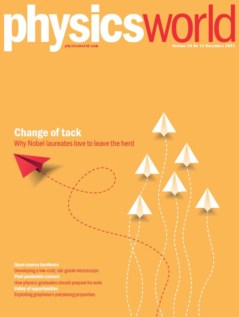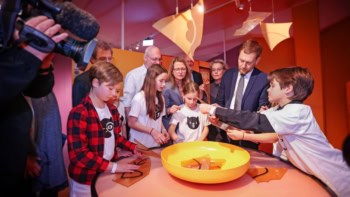The cover feature of the new issue of Physics World looks at why Nobel-prize-winning physicists just love to try their hands at new fields

With politicians gathering for the United Nations COP26 climate summit in Glasgow this month, the 2021 Nobel Prize for Physics is a reminder of just why physicists do such important work on so many fronts.
One half of the prize went to Syukuro Manabe and Klaus Hasselmann for developing vital physical models that reliably predict global warming. The other half went to Giorgio Parisi, for studying other equally complex systems, notably condensed-matter spin systems.
What’s interesting, though, is that many physicists who win a Nobel prize find the freedom it brings lets them carve out new research paths. Unfettered by the need to “prove” themselves or continue on the treadmill of bringing in grants, equipment and students, Nobel laureates can branch out into new research directions.
But tackling novel topics is usually second nature for Nobel laureates. In fact, as the cover feature of the latest issue of Physics World magazine reveals, very often the shift in focus began long before their prize was conferred.
If you’re a member of the Institute of Physics, you can read the whole of Physics World magazine every month via our digital apps for iOS, Android and Web browsers. Let us know what you think about the issue on Twitter, Facebook or by e-mailing us at pwld@ioppublishing.org.
For the record, here’s a rundown of what else is in the issue.
• Complexity pioneers bag Nobel prize – Syukuro Manabe, Klaus Hasselmann and Giorgio Parisi win award for their work on the physics of complex systems, as Michael Banks and Hamish Johnston report
• Learning from your mistakes – Caitlin Duffy says that physicists must recognize that failure is part and parcel of science
• Help me if you can – In his latest article on funding hi-tech firms, James McKenzie looks at the help on offer for businesses to innovate and grow

Physicists rise to the climate challenge: the October 2021 issue of Physics World
• Historical concerns – So you think the history of science is easy? Robert P Crease explains why it’s harder and more complicated than you might realize
• Life beyond the Nobel – Many physicists who win a Nobel prize find the freedom it brings lets them carve out new research paths. But often the shift in focus began long before their prize was conferred, as Physics World editors discover
• High-spec open-source microscopy for all – Open-science hardware offers unprecedented technological access to researchers and enthusiasts all over the globe. Richard Bowman and Julian Stirling of the Bath Open Instrumentation Group describe the lessons learnt in developing a low-cost, laboratory-grade microscope
• A valley of opportunities – After nearly two decades of graphene research, condensed-matter physicists Luis Foà Torres and Sergio O Valenzuela delve into the ongoing mystery of the material’s perplexing non-local response and the “valley Hall effect”
• Get stuck in – Jess Wade reviews Sticky: the Secret Science of Surfaces by Laurie Winkless
• Illuminating dark matter – Emma Chapman reviews Bright Galaxies, Dark Matter, and Beyond: the Life of Astronomer Vera Rubin by Ashley Jean Yeager
• Advice for post-COVID careers – COVID-19 has changed some aspects of the world of work forever, but others have stayed much the same. Andrew Hirst and Veronica Benson look at how physics students can prepare for careers in the post-pandemic world, and what universities and employers can do to help them
• Ask me anything – Careers advice from Ciara Muldoon, who helps run SearchScene, a search engine that helps tackle climate change and climate injustice
• The Geiger counter and the chair – Roberto Merlin on the meaning of a quantum-measurement system.



